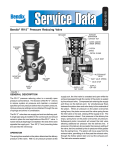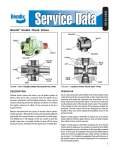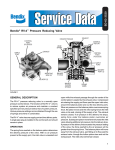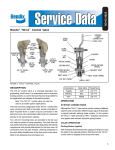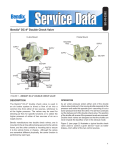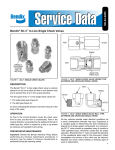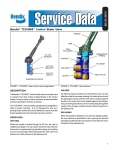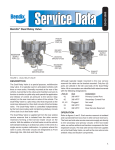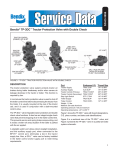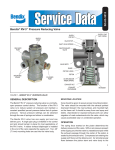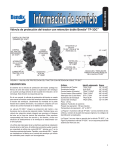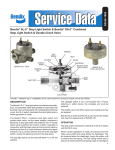Download BENDIX BW1592 User's Manual
Transcript
SD-06-130 ® Air Horns and Valves for air brake system components. At a minimum, the air horns and valves should be inspected every 6 months or 1500 operating hours, whichever comes first, for proper operation. Should the air horns and valves not meet the elements of the operational tests noted in this document, further investigation and service of the valve may be required. TESTING FOR SERVICEABILITY DESCRIPTION The purpose of our air horn is to provide a warning signal of greater volume and farther carrying qualities than usually found on automotive vehicles. The horn is designed on the principle of a vibrating diaphragm. The horn consists of die cast bodies, diaphragms, and two chrome plated horn bells, with the bells in a horizontal position. Two types of operating valves are commonly used, the foot-operated horn valve and the hand-operated horn valve. Each of these valves have a built-in strainer. OPERATING TEST 1. With air pressure in the system, operate the horn valve and the horn should give a loud, clear dual tone horn blast. LEAKAGE TEST 1. With horn valve in the released position, leakage at the delivery port or at the valve stem at the top of the horn valve should not exceed a 1” soap bubble in 5 seconds (100 SCCM). 2. With the horn valve applied, leakage at the stem at the top of the horn valve should not exceed a 1” soap bubble in 5 seconds (100 SCCM). REMOVING To remove the air horn or horn valve; OPERATION The horn is operated by pulling down on the lever of a hand-operated horn valve or pushing down on the button of the foot-operated horn valve. This action pushes down on the supply valve stem in the horn valve and opens the supply valve. When the supply valve in the horn valve is opened, air passes through the horn valve and enters the cavity in the air horn on one side of the diaphragms. As the air pressure builds up on the diaphragm, it deflects it and the air escapes through the horn bells. This action sets up a vibration of the diaphragm in each horn bell. The two different lengths of horn bells give the horn its dual tone. The vibrations are set up in an air column denser than atmosphere, due to escaping compressed air, which provides unusual tone carrying qualities. PREVENTIVE MAINTENANCE Important: Review the Bendix Warranty Policy before performing any intrusive maintenance procedures. A warranty may be voided if intrusive maintenance is performed during the warranty period. No two vehicles operate under identical conditions; as a result, maintenance intervals may vary. Experience is a valuable guide in determining the best maintenance interval AIR HORN 1. Disconnect the air line to the air horn. 2. Remove air horn mounting nut and remove horn. HORN VALVE 1. Drain air brake system. 2. Disconnect air lines to the horn valve. 3. Remove mounting bolts and remove horn valve. INSTALLING To install an air horn or air horn valve; AIR HORN 1. Mount horn on top side of vehicle roof or under hood. 2. Securely bolt horn on a flat surface and use care to be sure the body is not distorted. 3. The horn bells should point down slightly for adequate draining. 4. Install at least 1/4" O.D. tubing to the air horn. HORN VALVE 1. Mount the valve in the cab where it can be easily removed for servicing. 2. Mount so that pull-cord for the hand-operated valve will be within easy reach of driver. 3. Mount the foot-operated valve on floor in a convenient location for driver’s left foot. 4. Connect air lines to the horn valve. 1 DISASSEMBLY TEST OF REBUILT AIR HORN AND HORN VALVE AIR HORN 1. Remove the eight nuts and bolts holding the two covers to the body. 2. Remove the diaphragms from the body of the air horn. 3. Remove the spring contact, springs, and spring assemblies from the covers of air horn. 4. Remove the horn bells from the body. Both operating test and leakage test must be made after rebuilding or repairing an air horn or horn valve. If the air horn does not operate satisfactorily, adjustment of the spring load behind the diaphragm can be made by turning the adjusting screw in the cover. Before attempting to turn the adjusting screw, loosen the adjusting screw lock nut. Be sure to tighten the adjusting screw lock nut after any adjustment. HORN VALVE 1. Remove the spring cage from the valve body. 2. Remove the valve stem from the valve body. 3. Remove the strainer and spring from the spring cage. WARNING! PLEASE READ AND FOLLOW THESE INSTRUCTIONS TO AVOID PERSONAL INJURY OR DEATH: CLEANING AND INSPECTION AIR HORN 1. Wash all metal parts in cleaning solvent. 2. Carefully inspect the diaphragms to be sure they are not cracked, deteriorated, or distorted in any way. If ridges or cracks are found, the diaphragms must be replaced. 3. Inspect condition of the body. Be sure diaphragm seat in body is not chipped or damaged in any way. Check for cracks in the body. If these conditions prevail, replace body. 4. Inspect condition of the covers. Be sure diaphragm seat in cover is not chipped or damaged. Inspect the cover for cracks. If these conditions prevail, replace covers. 5. Inspect the horn bells. If they are cracked or broken, they should be replaced. 6. Inspect the spring contacts. If distorted or deteriorated, they should be replaced. 7. Check the spring. If broken, replace. HORN VALVE 1. Inspect supply valve and seat. If damaged, they should be repaired or replaced. 2. Check the spring. If broken, replace. 3. Be sure the valve stem does not bind when inserted in the valve body. ASSEMBLY NOTE: When using pipe thread sealant during assembly and installation, take particular care to prevent the sealant from entering the valve itself. Apply the sealant beginning with the second thread back from the end. AIR HORN 1. Place the diaphragms in the body. 2. Install the spring contacts, springs, and spring assemblies to the covers. 3. Install the eight bolts and nuts, attaching cover to the body. Care should be used to be sure equal pressure is exerted on all the screws holding the cover to the body. 4. Assemble the horn bells to the body. HORN VALVE 1. Insert the valve stem in the valve body. 2. Place the strainer and spring in the spring cage. 3. Assemble the spring cage to the body. 2 When working on or around a vehicle, the following general precautions should be observed at all times. 1. Park the vehicle on a level surface, apply the parking brakes, and always block the wheels. Always wear safety glasses. 2. Stop the engine and remove ignition key when working under or around the vehicle. When working in the engine compartment, the engine should be shut off and the ignition key should be removed. Where circumstances require that the engine be in operation, EXTREME CAUTION should be used to prevent personal injury resulting from contact with moving, rotating, leaking, heated or electrically charged components. 3. Do not attempt to install, remove, disassemble or assemble a component until you have read and thoroughly understand the recommended procedures. Use only the proper tools and observe all precautions pertaining to use of those tools. 4. If the work is being performed on the vehicle’s air brake system, or any auxiliary pressurized air systems, make certain to drain the air pressure from all reservoirs before beginning ANY work on the vehicle. If the vehicle is equipped with an AD-IS™ air dryer system or a dryer reservoir module, be sure to drain the purge reservoir. 5. Following the vehicle manufacturer’s recommended procedures, deactivate the electrical system in a manner that safely removes all electrical power from the vehicle. 6. Never exceed manufacturer’s recommended pressures. 7. Never connect or disconnect a hose or line containing pressure; it may whip. Never remove a component or plug unless you are certain all system pressure has been depleted. 8. Use only genuine Bendix ® replacement parts, components and kits. Replacement hardware, tubing, hose, fittings, etc. must be of equivalent size, type and strength as original equipment and be designed specifically for such applications and systems. 9. Components with stripped threads or damaged parts should be replaced rather than repaired. Do not attempt repairs requiring machining or welding unless specifically stated and approved by the vehicle and component manufacturer. 10. Prior to returning the vehicle to service, make certain all components and systems are restored to their proper operating condition. BW1592 © 2004 Bendix Commercial Vehicle Systems LLC All rights reserved. 4/2004 Printed in U.S.A.


